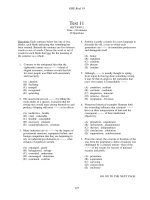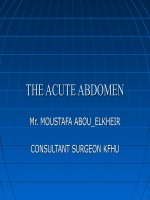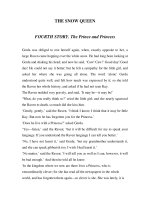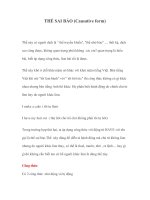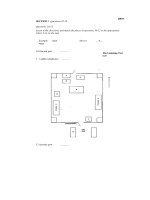Tài liệu The IELTS Test pdf
Bạn đang xem bản rút gọn của tài liệu. Xem và tải ngay bản đầy đủ của tài liệu tại đây (1.03 MB, 238 trang )
Copyright ©1996
School of Language and Literacy Education, University of South Australia
This publication is copyright. Except as expressly provided in the Copyright Act
1968 and
subsequent amendments, no part of this publication may be reproduced by any
means (including
electronic, mechanical, microcopying, photocopying, recording or otherwise)
without prior
written permission of the copyright owner.
ISBN 086803 142 9
ACKNOWLEDGEMENTS
The authors and publisher would like to express their gratitude to Stephen Slater
their editor and
to Frank Packenham for page layout, typesetting, visuals and editing assistance.
Thanks to: all
teachers and students at CALUSA who helped to trial the test practice materials,
in particular
Steve Cook, Joan Tobella and Barbara Reichert; to the students of ELP,
Universitas Islam Indonesia
for their assistance with trialling materials; the following people for their
assistance with the
recording of Listening and Speaking Test material—Pehr Abrahamsson, Kirill
Pogorelov, Maria
Mahamood, Rachael Kirkham, Rosemary Pimlott, Peter Forward, Alison Banks,
Mandy Rego,
Graham Ross, Neil Low, Peter Cowling and Shane McCarthy. Finally, thanks to
copyright owners
for permission to reproduce copyright material.
Cover design by Caroline Rannersberger.
Line drawings on pages 18,19,24, 29, 31,32 by Midori Nakamura and page 93 by
Peter Forward.
((OzArt clip art and Australian Heritage Illustrations by New Horizons.
Set in PalaBno using PageMaker 5.0.
japtinted by Printing and Publications Unit, University of South Australia.
Contents
Themes.....................................................................................................................2
The IELTS Test........................................................................................................4
Using this Book........................................................................................................6
Helpful Hints....................................................................................................:......8
Listening Practice Tests...............................................................:.........................13
Test 1.............................................................................................................15
Test 2.............................................................................................................24
Test3.............................................................................................................31
Reading PracticeTests...........................................................................................37
Test 1.............................................................................................................39
Test 2.............................................................................................................49
Test 3.............................................................................................................59
Test 4.............................................................................................................68
Test 5.............................................................................................................78
Test 6.............................................................................................................87
Test 7.............................................................................................................96
Test 8...........................................................................................................104
Test 9.................... ......................................................................................111
Writing Practice Tests .........................................................................................121
Test 1...........................................................................................................123
Test 2...........................................................................................................124
Test 3...........................................................................................................125
Test 4...........................................................................................................126
Test 5...........................................................................................................127
Test 6...........................................................................................................128
Test 7...........................................................................................................129
Test 8...........................................................................................................130
Test 9...........................................................................................................131
Self-Rating Guide........................................................................................135
Speaking Tests.....................................................................................................137
Test 1...........................................................................................................138
Test 2...........................................................................................................147
Transcriptions......................................................................................................159
Answer Key.........................................................................................................177
Sources.................................................................................................................182
Themes - Reading Tests
Test l
1
2
3
Test 2
1
2
3
Title
Theme
Finding the lost freedom
Rising seas
New rules for the paper game
Reducing city traffic
The warming of the Earth's oceai
Pollution-free paper making
How to raise a bright child
The value of driver training
Human powered pumps for
African farmers
Theories of childhood education
Do driver training programs wor
Primary technology in Africa
Test 3
1
Traditional Vietnamese medical
theory
The new supersonic boom
2
Co-housing
3
Test 4
1
That Monday morning feeling
2
Domestic division of labour
3
The Great Barrier Reef
Test 5
Wrap up your visit with the
perfect gift
2
Earthquakes
3
Why we can't afford to let Asia
starve
Test 6
1
Intellectual disability
Natural food as medicine
Building the new Concorde
Sharing domestic living space
Monday morning is a health risk
How husbands and wives share
household tasks
A fragile ecology at risk
Gift giving in various countries
Causes and effects of
A new look at food production
and distribution
Social responses to intellectual
disability
Efficient energy use in the
Living in the Antarctic
2
Fuel cells: 21st century electricity
3
The new Ice Age
Test 7
1
Tools for tomorrow's
Telecommunications
communications
2
Characteristics of open and
Studying without going to schoo
distance learning
3
Associations provide therapy for
The benefits of belonging to
society
groups
Test 8
1
Sustainable production
Recycling
2
Searching the skies
Looking for extra-terrestrial life
3
The problems of mature job
Age discrimination in the job
hunters
market
Test 9
1
A different taste of things to come Food preferences
2 , Fire tests
Discovering how fires start
3 • Some misconceptions about
Examining new findings about
Aboriginal Australia
Aboriginal history
Title
Theme
Causes of injury
Types of injury among different age
groups
2
Test 2
1
Vegetarianism
A meatless diet for godd health
Population growth
2
Test 3
1
Training for safe driving
Comparison between cities over a
25 year period.
The best way to reduce traffic accidents
2
Forests: the lungs of the
earth
Test 1
1
Test 4
1
2
Test 5
1
2
Test 6
1
2
Test 7
1
A waste disposal unit
Leisure at home
Safety standards for
building construction
Work time to buy
Children learn best by
observing adults
Description of the unjft and how it
works
Impact of the destruction of forests
life forms
How people spend their free time
at home
Government role in enforcing safety
standards
Changing amount of work needed.
to purchase consumer items
How children learn
Spending on civilian
applications world wide
Zoos
Comparison of spending between
countries
The value of keeping animals in zoos
One person households
The rise in one person households
during a 10 year period
Education is vital for the future
2
Test 8
1
Compulsory education
2
Tourism
Test 9
1
Sports injuries
2
Water
Women today
The status of women around the
world
Tourism as an important source of
national revenue
Emergency treatment for unjuries
from different sports
Sufficient clean water for the future
Themes - Writing Tests
The IELTS Test
IELTS means International English Language Testing System. It is an
internationally accepted English language test which assesses whether or not
your
English language skills are strong enough to commence studying at a university
or at a vocational college in an English speaking country.
Over 40,000 candidates sit for the IELTS test worldwide every year.
The IELTS test is not a test which you can pass or fail. IELTS tells you
something
about your English language weaknesses and strengths.
There are 4 subtests—Listening, Reading, Writing and Speaking.
Your result from each of these subtests is given individually on a scale from 1-9
and then all 4 scores are averaged to give the Overall Band Score.
An outline of each Overall Band Score is given below.
9 Expert User. Has fully operational command of the language: appropriate,
accurate and fluent with complete understanding.
8 Very Good User. Has fully operational command of the language with only
occasional unsystematic inaccuracies and inappropriacies. Misunderstandings
may occur in unfamiliar situations. Handles complex detailed argumentation
well.
7 Good User. Has operational command of the language, though with occasional
inaccuracies, inappropriacies and misunderstandings in some
situations. Generally handles complex language well and understands detailed
reasoning.
6 Competent User. Has generally effective command of the language despite
some inaccuracies, inappropriacies and misunderstandings. Can use and
understand fairly complex language, particularly in familiar situations.
5 Modest User. Has partial command of the language, coping with overall
meaning in most situations, though is likely to make many mistakes.
Should be able to handle basic communication in own field.
4 Limited User. Basic competence is limited to familiar situations. Has frequent
problems in understanding and expression. Is not able to use complex
language.
3 Extremely Limited User. Conveys and understands only general meaning in
very familiar situations. Frequent breakdowns in communication occur.
2 Intermittent User. No real communication is possible except for the most
basic
information using isolated words or short formulae in familiar situations and
to meet immediate needs. Has great difficulty understanding spoken and
written English.
1 Non User. Essentially has no ability to use the language beyond possibly a
few
isolated words.
When you decide that you would like to do further study in an English speaking
country, the university or college you apply to will say what minimum score
you
will need in order to enrol in the course of study you have chosen. This score
will
probably be between 5.5 and 7.0. Some universities also require a minimum
bandscore on a particular subtest, such as Writing or Speaking.
The Listening and Speaking subtests focus on general English.
The Reading and Writing subtests are more closely related in content to
academic
styles of English.
The subtests are always taken in the following order
LISTENING
4 sections, around 40
items
30 minutes
READING
3 sections, around 40
items
60 minutes
WRITING
2 tasks (150 & 250
words)
60 minutes
SPEAKING
10-15
minutes
Total Test Time: 2 hours 45 minutes
Questions most often asked about the IELTS test
Do / have to do all 4 sections of the test?
Yes you do. The Overall score is calculated as an average of all 4 subtests.
If I don't get the score I need, can I do the test again?
You will have to wait 3 months before you can do another test.
How soon can I get my results?
Most IELTS test centres can give you your results within 1 week.
For further information about the IELTS test, you can refer to The IELTS
Handbook,
Using this Book
To the student
These 3 complete Listening tests, 9 complete Reading tests, 9 complete Writing
tests and 2 Speaking tests, have been prepared so that you can practise on your
own or in a classroom with the help of a teacher. They have been trialled with
students at different levels and at language centres internationally. Feedback
from
trialling has been incorporated at each stage of development.
Procedure for Listening, Reading and Writing Tests
Do these practice tests under strict test conditions.
Time yourself carefully and do not use a dictionary.
You may photocopy the blank answer sheets at the beginning of each test
section
or use your own paper.
You can practise the tests in the correct order or select tests according to
thematic
interest, using pages 2 and 3.
Listening tests
In each test there are 4 sections.
• All dialogues and instructions for each test are on the audio tape, cassette 1.
• Play the audio tape right through once without stopping.
• Write your answers as you listen.
• Photcopy the answer sheet and practise transferring your answers onto it.
Reading tests
In each test there are 3 reading passages.
• Read the instructions carefully.
• Start at the beginning.
• Follow the suggested time for each set of questions.
• Photcopy the answer sheet and write your answers directly onto it.
Writing tests
In each test there are 2 tasks.
• Read the questions carefully.
• Answer both tasks.
• Follow the suggested time and length for each task.
Procedure for Speaking Tests
• Work through the exercises using the audio tape, cassette 2.
• Use the transcripts at the end if you want to listen to and read the interviews.
• Practise with a partner if you can.
This symbol appears in various places. It is there to remind you to carry out
one or more of the following activities after you have finished a task or a test.
Check your answers to the Listening, Reading and Speaking tests using the
Answer key at the back of the book.
• Rate your performance on the Writing tasks using the Self-Rating Guide on
pages 135 and 136.
• Carry out the Reflection tasks at the end of each subtest section.
To the teacher
If the IELTS test is new to you, you will find the introductory description of the
test on pages 4 and 5 useful. You will probably also wish to go through that
section
with your students to forestall some of their queries. If your students have not
done the IELTS Test before you may find it helpful to go through a test, section
by
section in class, discussing the question types at some length. You may also wish
to draw your students' attention to the Hints and Reflections for each subtest and
discuss them further as you think necessary. Here are some quick hints for you to
follow as you prepare your students for the test using IELTS Practice Now.
Listening Tests
• Work through one section at a time before doing a full test.
• Do under test conditions so that students get used to hearing the material once
only.
• Give students practice in transferring their answers to separate sheets of paper
as required in the real test.
• Go over the answers with your class, playing the tape again to clarify any
difficult questions.
• Discuss strategies - How to use the time given to scan questions.
- What to do if a question is missed or not understood.
Reading Tests
• Use Themes—Reading Tests, page 2, for guidance as to the content of the
reading tests, in case you wish to concentrate on a particular theme.
• Work through one section at a time, pointing out the different question types,
before doing a full test. Focus on the question types your students find
difficult.
Writing Tests
• Set as homework tasks or do in the classroom under strict test conditions.
• Give the students timed practice to help them organise themselves under test
conditions.
• Do follow-up work on the particular aspects of writing you feel need
developing, such as understanding and answering the question, developing an
argument, using appropriate register, improving sentence structure, or any
.other skills normally required for academic writing.
Speaking Tests
• Do the exercises individually or in small groups.
• Give students opportunities to practise all four phases
• Remember that your role as mock examiner will be important here in providing
authentic practice and relieving the stress that this subtest tends to cause.
• Help students to develop expressions which are useful when handling
hesitation or misunderstanding.
• Use the transcripts to point out any features of conversational ability that
demonstrate a candidate is comfortable with English in an interview situation.
Help the students understand that the skills required are useful, not just for the
test, but for reading and writing in academic contexts and for listening to and
speaking with native speakers.
HELPFUL HINTS
Hints for Test Day
Drink water.
Eat a healthy breakfast
Arrive at least half an
hour
before the test starts
so you can remain calm.
Make sure you know
when and where
your speaking test is.
Don't panic.
Panic makes you lose concentration.
Make sure you know your candidate number.
Listen carefully to all the instructions.
If the room is too noisy, tell the teacher.
If you can't hear the
tape clearly
in the listening test,
tell the teacher.
During the break between the
reading and writing tests,
leave the room, have a drink of
water and walk around.
Hints for the Listening Test
Questions
What if I can't hear
the tape very well?
Where do I write
my answers?
Should I answer the
questions as I listen?
What if I miss
a question?
Can I look at
the questions
before hear the
dialogues?
Is there
time to check my
_ answers?
Hints
You should tell the
teacher immediately.
Write them in the question
booklet. At the end of the
test transfer your answers
to the answer sheet.
Yes. Don't wait till the end
of the section because you'll
forget the answers.
Don't panic. Keep going.
You may have a chance
to go back to do it later.
There's time before each
section for you to look
ahead at the questions .
There's time to check your
answers at the end of each
section and at the end of the
whole test.
Hints for the Reading Test
Questions
Can I write the
answers in the
question booklet?
How can
I
use time
Hints
Hints for the Writing Test
Questions
Hints
Should I do Writing
Task 1 before
Task 2?
Answer the task you feel
most confident about first.
If Task 1 looks easier than
Task 2, do that first.
My spelling is
weak.
Will my spelling
mistakes ruin my
score?.
What if I don't
keep to the
recommended
— times? __
Is it OK to write
in pencil?
A few spelling mistakes
should not affect your score.
The time lines are suggestions
only but it's wise to spend 20
minutes on Task 1 and 40
minutes on Task 2, since Task 2
is worth more than Task 1.
Pencil is allowed but make
sure it is dark enough to be
easily read by the assessor.
r
Hints for the Speaking Test
Questions
How can I prepare myself
for the speaking interview?
What should I do if
I don't understand
the interviewer?
What if I can't think
of anything to say
. straightaway? .
Is it better to speak
accurately?
What if my
pronunciation is
not very good?
Hints
Practise speaking as much
English as possible in a
relaxed and friendly way.
Don't rehearse!
Ask the interviewer to
repeat the question. Don't
panic.
Ask the interviewer to
give you a few moments
to think.
The best speaking is a
natural
conversation.
Smile and enjoy yourself.
Try to give your voice variety
of tone to show that you are
lively and interested.
LISTENING PRACTICE TESTS
There are 3 listening practice tests
Time allowed for each test: 30 minutes
Before vou start
All the dialogues and instructions for each test are on the audio
tape.
When you are ready to begin the test, start the tape.
DO NOT STOP THE TAPE BEFORE THE TEST IS FINISHED.
Photocopy the answer sheet on the next page and practise
transferring your answers onto it.
When you have finished each test, check your answers with the
answer key on page 177.
LISTENING ANSWER SHEET
Photocopy this page to write your answers to each Listening test you practise.
Test number:
Enter the number
in the boxes and
shade the number
in the grid.
1
2
3
4
5
6
7
8
9
10
11
12
13
14
15
16
17
18
19
20
21
22
23
24
25
26
27
28
29
30
31
32
33
34
35
36
37
38
39
40
Band Score
Listening Total
LISTENING TEST 1
SECTION 1
Questions 1-9
Questions 2-4
Write your answers in the spaces provided.
Example:
COMPUTER
Room B100
COMPUTERS IN
THIS ROOM
COMPUTERS FOR
USE ONLY
MAXIMUM TIME
FOR EACH BOOKING
4.
OPENING TIMES
MON-FRT
SAT-SUN
Questions 5-9
Complete the following statements as briefly as possible.
5.
To obtain paper for printing insert
6.
Automatic ____________________________ checks for computer virus.
7.
Barbara's student number is______________________________
8.
To book a computer, students have to write their____________________
and ___________________in the book.
9.
No ---------------------------or ____________________in the computer
room.
SECTION 2
Questions 10-16
Circle the correct letter.
Example: Barbara and Ricardo have
A passed their exams
C finished their course
(B) finished their exams
D failed their exams
10. Circle the correct letter.
How much will it cost each person for the riverboat trip?
A
$30
B
$20
C
$25
D
$5
11. Circle TWO correct letters.
Indicate the TWO reasons why Barbara and Ricardo decide NOT to go
horseriding.
A
it's too expensive
B
they haven't got the right equipment
C
it's too far away
D
Ricardo can't ride a horse
E
they don't want to catch a bus
12. Glide the correct letter.
How much was quoted in the brochure for the hire of a mountain bike?
A
$20 per day + $10 deposit
B
$10 per day + $20 deposit
C
$30 per day + $10 deposit
D
$30 per day + $20 deposit
13. Circle the correct letter.
Where is the bicycle hire place?
14. Circle the correct letter.
What is included in the hire charge?
A
helmet, panniers and lights
B
panniers and repair kit
C
helmet and repair kit
D
repair kit, helmet and lights
15. Circle the correct letter.
What did Barbara and Ricardo hire?
A
B
c
D
16. ON the receipt below, write in the correct total amount paid by Barbara
and Ricardo.
Receipt for Bicvcle Hire
Amount received:
$
Date: ____ 6 ]une __
SECTION 3
Questions 17-30
Questions 17-23
Loot at the statements numbered 17-23. As you listen, circle T if the statement is
true, F if the statement is false or N if there is no information given.
Example:
All students have to write an assignment
17. Work experience is organised by the student
T
T
F
F
( N)
N
18. Work experience is part-time work
T
F
N
19. Barbara has almost completed her course
T
F
N
20. Work experience is paid
T
F
N
21. The student has to write a report about the company
T
F
N
22. The company has to write a report about the student
T
F
N
23. Barbara has applied to other companies
T
F
N
24. Circle the correct letter.
A
Barbara felt confident that she would be accepted by the company
B
The secretary assured Barbara she would be accepted by the company
C
Barbara hoped she would be accepted by the company
D
Barbara did not feel confident she would be accepted by the company
Questions 25-30
Complete the message below.
MESSAGE
25 Name
26
Miss
Ms
Mrs Mr
27 Address No
Street:
Suburb:
28 Forestville.
29 Phone:
Postcode:
3 Best time to call:
0
(Circle one)
SECTION 4
Questions 31-40
31. Circle the correct letter.
Which is the most dangerous seat in a car?
A front left
B
front right
C back left
D
back right
32. Circle TWO letters.
From the following list, which TWO things have the greatest effect
on
the severity of injury in a car accident?
A age of driver
B blood alcohol level
C sex of driver
D seating position
E
kind of vehicle
F
age of vehicle
Questions 33-34
What TWO factors have previously been the focus of safe driver
education?
33.____________________________
34. ___________________________
35. Write TWO words.
Which kind of vehicle is the most dangerous?



